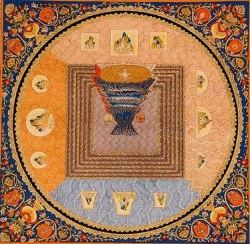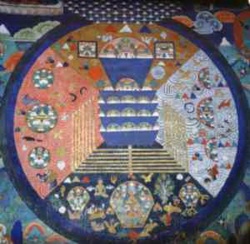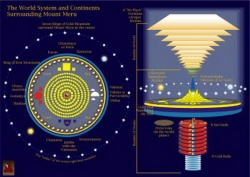Mount Meru: The Center of the Universe?
Buddhist texts and teachers sometimes refer to Mount Meru, also called Sumeru (Sanskrit) or Sineru (Pali). Mount Meru is a sacred mountain in Buddhist, Hindu and Jain mythology. For a time, the existence (or not) of Meru was a heated controversy.
Ancient Buddhists thought Meru was the center of the universe. The Pali Canon records the historical Buddha speaking of it. In time, ideas about Mount Meru and the nature of the universe became more detailed. For example, a renowned Indian scholar named Vasubhandhu (ca. 4th or 5th century CE) provided an elaborate description of the Meru-centered cosmos in the Abhidharmakosa.
The Buddhist Universe
Ancient Buddhists imagined the universe as essentially flat, with Mount Meru at the center of all things. Surrounding this universe was a vast expanse of water, and surrounding the water was a vast expanse of wind.
This universe was made of thirty-one planes of existence, stacked in layers, and three realms, or dhatus. The three realms were Ārūpyadhātu, the formless realm; Rūpadhātu, the realm of form; and Kāmadhātu, the realm of desire. Each of these was further divided into multiple worlds that were the homes of many sorts of beings. This cosmos was thought to be one of a succession of universes coming into and going out of existence through infinite time.
Our world was thought to be a wedge-shaped island continent in a vast sea south of Mount Meru, called Jambudvipa, in the realm of Kāmadhātu. The earth, then, was thought to be flat and surrounded by ocean.
The World Becomes Round
As with the sacred writings of many religions, Buddhist cosmology can be interpreted as myth or allegory. But many generations of Buddhists understood the universe of Mount Meru to exist literally.
Then, in the 16th century, European explorers came to Asia claiming the earth was round and suspended in space. And a controversy was born.
Donald Lopez, a professor of Buddhist and Tibetan studies at the University of Michigan, provides an illuminating account of this culture clash in his book Buddhism and Science: A Guide for the Perplexed (University of Chicago Press, 2008). Conservative Buddhists rejected the round world theory. They believed the historical Buddha had perfect knowledge, and if the historical Buddha believed in the Mount Meru cosmos, then it must be true.
Some scholars, however, adapted what we might call a modernist interpretation of the universe of Mount Meru. Among the first of these was the Japanese scholar Tominaga Nakamoto (1715-1746). Tominaga argued that when the historical Buddha discussed Mount Meru, he was only drawing upon the understanding of the cosmos common to his time. The Buddha did not invent the Mount Meru cosmos, nor was belief in it integral to his teachings.
Stubborn Resistance
However, a great many Buddhist scholars stuck to the conservative view, that Mount Meru was "real." Christian missionaries tried to discredit Buddhism by arguing that if the Buddha was wrong about Mount Meru, his teachings couldn't be trusted. It should be noted that most of these same missionaries believed the sun revolved around the earth.
Faced with this foreign challenge, to some priests and teachers defending Mount Meru was tantamount to defending the Buddha himself. Elaborate models were constructed and calculations made to "prove" astronomical phenomena were better explained by Buddhist theories than by western science. And of course some fell back on the argument that Mount Meru existed, but only the enlightened could see it.
In most of Asia the Mount Meru controversy continued until late in the 19th century, when Asian astronomers came to see for themselves that the earth was round, and educated Asians accepted the scientific view.
The Last Holdout: Tibet
Professor Lopez writes that the Mount Meru controversy didn't reach isolated Tibet until the 20th century. A Tibetan scholar named Gendun Chopel spent the years 1936 to 1943 traveling in south Asia, soaking up the modern view of the cosmos that by then was accepted even in conservative monasteries. In 1938 Gendun Chopel sent an article to the Tibet Mirror informing his country persons that the world is round.
The current Dalai Lamao has flown about the round world several times, seems to have put an end to flat earthism among Tibetans by saying the historical Buddha was wrong about the shape of the earth. However, "The purpose of the Buddha coming to this world was not to measure the circumference of the world and the distance between the earth and the moon, but rather to teach the Dharma, to liberate sentient beings, to relieve sentient beings of their sufferings."
Even so, Donald Lopez recalls meeting a lama in 1977 who still held onto a belief in Mount Meru.
Mount Meru in the West
In the West, in some Buddhist traditions, little is said these days about Mount Meru. It seems only to be a quaint bit of irrelevant trivia that pops up in sutras from time to time. Possibly some mistake the mythical Mount Meru for an African mountain of the same name. In other traditions, the old cosmology is still taught as a metaphysical model.
The historical Buddha taught us about the nature of suffering and the means to be liberated from it, not to teach us facts about the phenomenal universe. This might teach us to be cautious about linking Buddhism and science too tightly. There is no need for Buddhism and science to contradict each other, but they are not necessarily about the same things.


